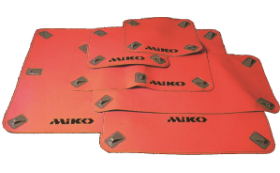It has been confirmed that the rapid availability of magnetic patches from Miko Marine AS ensured the speedy closure of sea chests during pumping operations to save the cruise ship Nordlys. The emergency salvage work took place on 15 September in the Norwegian port of Ålesund after an engine room explosion at sea caused hull damage that resulted in two fatalities. The subsequent fire led to the rapid evacuation of the ship’s 207 passengers and 55 crew from the Hurtigruten-operated cruise ship which was towed to port.
The m/s Nordlys was made fast alongside the Ålesund quay where several pumps were installed to counter the flooding. The location of the hull damage was, however, unknown and with a list of 21.7 degrees the ship was in imminent danger of capsize. The salvage teams consequently needed to seal all of the ship’s thruster sea chests to eliminate them as potential sources of the leak.
Four magnetic patches were quickly delivered to the ship accompanied by a Miko supervisor who was able to advise divers on their use. A fifth non-magnetic Miko patch was also used as this had become available before the magnetic patches arrived. Additional Miko high power magnets were also applied to the patches to guarantee their adhesion during the subsequent sea transit.
The leak was ultimately identified as a 38 cm by 8 cm tear that was effectively closed by divers using traditional wooden plugs. This enabled the ship to be pumped out and safely towed to dry dock in Sula for repair the following week.
Speaking after the event Nicolai Michelsen, managing director of Miko Marine, said; “This was an incident where the salvage team was able to use our magnetic patches on a job for which they are ideal. The ability to safely close a ship’s sea chests can save an owner significant amounts of money if dry docking is the only alternative option available.
Emergency repairs inside a thruster tunnel, for example, or to part of a ship’s pumping or filtration infrastructure can result in docking fees that may be way out of proportion to the complexity of the task involved. The magnetic patches are qualified by DnV for this purpose which means that a sea chest can be quickly sealed and pumped dry so that work can be carried-out inside in complete safety.
Miko magnetic patches have now been used on numerous occasions when they have saved many types of vessel from sinking. However, the simplicity of the concept denies the technology and years of research that went into them. Each patch must achieve a powerful bond despite what may be many layers of paint or corrosion covering the metal. This is achieved by mixing rare earth particles with an exceptionally strong blend of Nitrile rubber. With a stretch strength of 9000 N per 5 cm it means that a 5 cm strip of the fabric can lift a car and is therefore more than adequate for most repair applications.
When the rare earth particles are mechanically rolled together with the rubber they become distributed in parallel lines. Because of this, when they are magnetised they become intensely powerful and this necessitated further study to identify the most suitable rubber compound. A soft rubber is more flexible and achieves a better seal but it can also allow the powerful magnetic particles to realign themselves and lose the benefit of being arrayed in parallel lines. A finished patch will weigh 10 kgs per square metre so an additional layer of material is laminated to the patch to provide buoyancy. With lifting lugs also fitted it can be easily manoeuvred into position under water by divers. Once in place the powerful magnetic bond can be reinforced by additional magnets as occurred on the Nordlys. These create a dependable water tight seal that will enable the vessel to remain seaworthy during passage.



